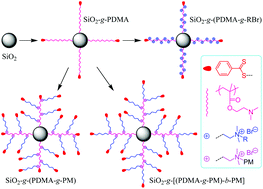Youliang Zhao*a(赵优良)
a Suzhou Key Laboratory of Macromolecular Design and Precision Synthesis, Jiangsu Key Laboratory of Advanced Functional Polymer Design and Application, College of Chemistry, Chemical Engineering and Materials Science, Soochow University, Suzhou 215123, China
Polym. Chem. 2015, 6, 2647-2658
Facile construction of solid substrates grafted with quaternized copolymers by two step reactions comprising the alkoxysilane–hydroxyl coupling reaction, quaternization and RAFT polymerization is described. Silica nanoparticles grafted with poly(N,N-dimethylaminoethyl methacrylate) (PDMA) were initially prepared via tandem linking reaction and RAFT polymerization and acted as a versatile platform to generate three types of ion-bearing topological copolymers grafted silica. Bromide-functionalized agents and polymers were grafted onto the surface-tethered PDMA backbone to form quaternized random and comblike copolymers grafted silica, and concurrent quaternization and RAFT processes were performed to generate silica nanoparticles grafted with toothbrushlike copolymers comprising poly(methyl methacrylate), polystyrene, poly(N-isopropylacrylamide) and poly(tert-butyl acrylate) segments. Free polymers and grafted side chains obtained by a tandem approach usually have similar chain length and low polydispersity, as evident from hydrolysis, GPC and 1H NMR analyses. The quaternization efficiency of graft reactions was in the range of 34–79% (for attaching small molecules) and 3.8–7.4% (for grafting polymeric chains). Our preliminary results revealed that the surface wettability of hybrid films was dependent on some factors such as macromolecular architecture, quaternization degree, chemical composition and temperature. This study affords a straightforward and versatile method to construct quaternized macromolecular architectures grafted onto hydroxyl-rich solid substrates, and the resulting silica–polymer hybrids may have a great potential in stimuli-responsive emulsifiers, surface and antibacterial materials.

链接:
//pubs.rsc.org/en/Content/ArticleLanding/2015/PY/c4py01741b#!divAbstract